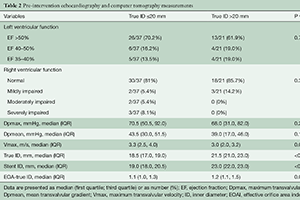Transcatheter valve-in-valve implantation in degenerated aortic bioprostheses: are patients with small surgical bioprostheses at higher risk for unfavourable mid-term outcomes?
Abstract
Background: To examine outcomes of valve-in-valve (ViV) transcatheter aortic valve implantation (TAVI) according to the inner diameter (ID) of the degenerated aortic valve bioprosthesis.
Methods: We analyzed survival, stroke, permanent pacemaker (PPM) implantation, paravalvular (PV) leakage, acute kidney injury and vascular complications in fifty-nine patients during a ten-year period. Patients were stratified according to the ID of the indwelling degenerated biological aortic valve (true ID ≤ and >20 mm). Differences in post-procedural transvalvular gradients and hospital re-admissions were analyzed.
Results: The median age of the small diameter group and large diameter group was eighty-one and eighty years, respectively. Median logistic EuroSCORE I was 23.9% and 26.2% and median Society of Thoracic Surgeons (STS) score was 5.7% and 7.8% for the small and large groups, respectively. Survival, stroke, PPM implantation, PV leakage, acute kidney injury and vascular complications did not reach any statistically significant difference between both groups. Postprocedural transvalvular gradients differed significantly according to the true ID of the degenerated bioprosthetic valve and consequently of the respective TAVI valve. There was a significant difference with regard to hospital readmissions according to the true ID.
Conclusions: TAVI ViV implantation for aortic bioprostheses with small true IDs of ≤20 mm is associated with comparable mid-term mortality and periprocedural stroke rate compared to implantation into larger bioprostheses. However, the periprocedural and mid-term transvalvular gradients, as well as hospital
re-admission rates are significantly higher in the small diameter group.
Cover






